Coty Ends FY22 With Double-Digit Sales And Profit Growth Ahead of Guidance
SHARE WITH :
Financial IMAGES
- Robust sales growth in both divisions, led by Europe and travel retail
- Continued gross margin expansion, despite inflationary environment
- Strong FY22 cash flow and deleveraging progress
- FY23 revenue and profit expected to grow in-line with medium-term targets
NEW YORK - August 25, 2022-- Coty Inc. (NYSE: COTY) ("Coty" or "the Company") today announced its results for the fourth quarter of fiscal year 2022, ended June 30, 2022. The Company delivered its eighth consecutive quarter of results in-line to ahead of expectations, while also continuing to progress across each of its strategic growth pillars.
In Q4, Coty's sales increased 10% as reported and 16% on a LFL basis, including over 150 bps of negative impact from exiting its Russia business, ahead of its prior guidance for low-double-digit LFL growth in Q4. As a result, Coty ended FY22 with reported sales growth of 15% and LFL sales growth of 16%, above its original target of low-teens LFL sales growth and well ahead of the underlying beauty market, putting Coty amongst the best in its competitive set.
Coty's sales were driven by strong and consistent momentum in both divisions, with Prestige growing 20% as reported and 22% LFL in FY22, and Consumer Beauty growing 7% as reported and 8% LFL in FY22. Geographically, revenue improvement was fueled by double-digit growth across nearly all EMEA markets, the doubling of sales in Travel Retail enabled by Coty's category expansion and premiumization strategy, double digit growth in Brazil which continues to successfully manage the highly inflationary environment, and continued momentum in the U.S.
E-commerce continued its strong performance, with double-digit sales growth in Q4 and FY22, supporting high teens e-commerce penetration for the year.
Coty's Prestige segment led during the quarter with reported sales growth of 16% versus the prior year and 23% growth on a LFL basis. Prestige fragrance sales remained robust, delivering another quarter of growth over 20% in Q4 and ahead of the overall category. Nearly all brands in the segment delivered robust double-digit growth, with particular strength from Hugo Boss, Burberry, Chloé, Calvin Klein, and Gucci Beauty. The performance was driven by the continued in-market success of Coty's FY22 fragrance innovations, including Burberry Hero and Burberry Her EDT, Hugo Boss The Scent Le Parfum and Boss Bottled Marine, and Gucci Flora Gorgeous Gardenia. Prestige cosmetics also continued to deliver strong double-digit growth in Q4.
Consumer Beauty revenue rose 3% as reported and 7% LFL in Q4, with growth across all product categories and nearly all key brands. During the quarter, the total global mass beauty market increased at a mid-single-digit rate versus last year, while Coty outperformed the market and continued to gain share on a global basis. In fact, June marked the eighth consecutive month of market share growth, with the largest year-over-year increase in market share to date. Encouragingly, CoverGirl's share performance improved exiting the quarter, driven by the very strong in-market performance of the recently launched Exhibitionist Stretch & Strengthen Mascara and as its temporary supply constraints on key products subsided. During June, Rimmel and Max Factor both gained global market share. Rimmel's performance was supported by the continued strength of its Kind & Free line of clean, vegan beauty, and Max Factor by the launch of its Miracle Pure skinified foundation and re-activation of its iconic franchises. Complementing the strength in its cosmetics category, Coty also gained share in bodycare and mass fragrances, led by key brands Bruno Banani, David Beckham, and Monange.
During Q4, Coty continued to generate very robust gross margin expansion, allowing for an increased level of media investment, in turn further fueling revenue and sell-out performance. In the quarter, reported gross margins increased by 140 bps YoY to 61.8%, while adjusted gross margin grew 120 bps YoY to 62.1%. For FY22, Coty delivered a reported gross margin of 63.5% and adjusted gross margin to 63.7%, a robust expansion of 370 bps YoY, even as inflationary headwinds worsened throughout the year to over 2% of revenues in Q4. Coty's Q4 gross margin improvement was driven by strong pricing and mix momentum in both Prestige and Consumer Beauty, divisional mixshift, and stronger absorption from volume growth.
Coty delivered Q4 reported operating loss of $77.4 million and adjusted EBITDA of $132.4 million. Coty delivered FY22 adjusted EBITDA of $905.3 million, slightly ahead of guidance of approximately $900M, reflecting 19% growth YoY. Driven by the strong profit expansion and significant improvement in Coty's capital structure - including a substantial reduction in convertible preferred stock and lower interest expense through our deleveraging efforts - Coty's reported FY22 EPS grew to $0.08 and adjusted FY22 EPS grew by 5x YoY to $0.28.
Financial Net Debt at the end of Q4 sequentially remained relatively stable at $4.3 billion and improved substantially by $0.9B versus the prior year through Coty's active deleveraging efforts, including free cash flow generation of $552.5 million. As a result, Coty's Q4 financial leverage ratio of 4.7x remained consistent with Q3, a decline of over 2 turns versus the prior year. During the year, Coty received multiple ratings upgrades from the leading rating agencies, reflecting its strong progress in strengthening its balance sheet. At quarter end and based on Coty's methodology, Coty's Wella Company stake was valued at approximately $0.8 billion, reflecting Wella's exit from Russia as well as the market driven increase in the discount rate. At the same time, Wella continues to perform ahead of plan and with Wella having recently completed the acquisition of a high growth haircare company, Coty would expect this to drive value expansion in Wella over time. Factoring in the retained Wella stake, Coty's Economic Net Debt totaled approximately $3.4 billion.
Commenting on the operating results, Sue Y. Nabi, Coty's CEO, said:
"Today marks the end of another successful year at Coty as we continued to make significant progress strategically, operationally, and financially. We have also demonstrated the sustainability of Coty's turnaround in the business by delivering eight consecutive quarters of results in-line to ahead of expectations. While the external environment became increasingly complex through the year, Coty proved resilient through operational excellence that enabled us to surpass our guidance and deliver double-digit sales and EBITDA growth. We have generated sales growth in both Q4 and FY22 that is well above the underlying beauty market and among the best in our competitive set.
While macro concerns continue to dominate headlines, it's important to remember that beauty is amongst the most resilient discretionary categories. It is upon us and our peers to inspire consumers and create new demand through innovative products, new looks, and disruptive campaigns. We therefore remain committed to protecting our media investments going forward. In this context, Coty's presence in both premiumized mass beauty and prestige beauty is a crucial asset in the current macroeconomic environment.
I am also pleased to say that we continued to make strong progress across each of our strategic pillars. Starting with Consumer Beauty, the business continued to gain market share globally during Q4, marking eight consecutive months of expanding market share. This momentum was supported by the re-positioning of our key brands, including CoverGirl, Rimmel, and Max Factor. Importantly, we are just getting underway with the repositioning of Adidas, and I look forward to sharing these results with you in the coming quarters.
Our Prestige fragrance business continued to deliver outstanding growth, increasing 18% as reported and 26% LFL during the quarter, supported by robust category trends, which remain nicely above pre-pandemic levels, coupled with the success of our recent innovations. Encouragingly, we made additional progress expanding into Prestige cosmetics and have plenty of white space to build out both distribution and product portfolios for each of our brands.
We continued building out our skincare business in Q4, and remain well-positioned as we enter FY23. In the quarter, Lancaster was the #2 exclusive brand at Sephora China, and was #3 amongst niche skincare brands in key Hainan retailers. In June, we launched SKKN by Kim and have been pleased to see revenues coming in ahead of plan.
For our fourth strategic pillar, Digital, the momentum continued through the quarter with e-commerce sales increasing at a mid-teens pace, supported by our efforts across livestreaming and social commerce, TikTok activations, virtual try-on capabilities, and an expanded e-commerce presence.
Progress on our fifth strategic pillar, expanding our presence in China, was impacted by the resurgence of COVID and related restrictions during much of the quarter. However, I am pleased to say Coty's Prestige sell-out grew double digits in FY22, far ahead of the market which declined modestly.
Finally, we made strong strides in our sixth strategic pillar, sustainability, with multiple innovations, including clean formulations, more sustainable packaging, and animal friendly. We took upcycling to the next level through our partnership with LanzaTech by beginning to manufacture prestige fragrances utilizing carbon-capture based ethanol, which is the #1 ingredient in fragrances.
With continued momentum in the fragrance category, Europe and global travel retail, and a strong pipeline of innovation, we expect FY23 to be a year of continued expansion, in-line with our medium-term growth targets. At the same time, we remain vigilant in monitoring the ever-evolving macro backdrop, with resilience plans developed to support the business should conditions worsen.
In summary, our balanced portfolio, covering key categories, channels, price tiers, and geographies; our portfolio of iconic key brands which continue to solidify their positionings and gain share; and our substantial white space opportunities in skincare, China and Travel Retail, all reinforce Coty's attractive value proposition in the historically resilient beauty market. Our virtuous cycle will only further strengthen the Company, allowing for continued above-market sales growth and gross margin expansion, resulting in fuel for brand reinvestment, profit improvement, and further deleveraging. We remain committed to growing Coty's position as a true beauty powerhouse."
*Adjusted financial metrics used in this release are non-GAAP. See reconciliations of GAAP results to Adjusted results in the accompanying tables.
E-commerce revenues and penetration cover the vast majority of Coty’s markets and exclude certain markets like Travel Retail in EMEA and Americas. Additionally, the data includes estimated data for Brick and Click sales, which may be subject to change.
Highlights
- 4Q22 net revenues increased 10% as reported and 16% on a LFL basis, including over 150 bps of negative impact from its Russia business exit. Net revenue trends were driven by strong growth in both Prestige and Consumer Beauty. For FY22, net revenues increased 15% as reported and 16% LFL.
- Reported operating loss totaled $77.4 million in 4Q22, while the FY22 reported operating income was $240.9 million, up close to $290 million YoY.
- 4Q22 adjusted operating income increased to $65.1 million from $45.3 million in the prior year, while FY22 adjusted operating income expanded 41% YoY to $615.5 million as gross margin improved and depreciation declined.
- 4Q22 adjusted EBITDA was $132.4 million, up modestly YoY, while FY22 adjusted EBITDA was $905.3 million, ahead of guidance, and up 19% YoY, fueling a 60 bps increase in the adjusted EBITDA margin to 17.1%.
- 4Q22 reported EPS was $(0.34), while 4Q22 adjusted EPS of $(0.01), improved from $(0.08) last year.
- FY22 reported EPS was $0.07. FY22 Adjusted EPS came in at $0.28, above guidance of $0.23-0.27, and up from $0.05 last year.
- Consistent with previous outlook comments, net savings were relatively neutral in Q4, bringing the FY22 total to over $90 million.
- 4Q22 free cash outflows of $74.0 million were $76.1 million greater than last year driven by one-time phasing impacts.
- Financial Net Debt was $4,265.2 million, relatively consistent with Q3, with the financial leverage remaining at 4.7x and down 2 turns versus the prior year. Economic Net Debt totaled $3,435.2 million at quarter end.
- Reflecting Coty's significant progress in improving its financial and operational performance, all while strengthening its balance sheet, the Company gained recognition from both equity investors and debt rating agencies. Coty achieved two ratings upgrades during FY22 from each of the leading rating agencies, with Coty now rated at B+ by S&P and B1 by Moody's. At the same time, according to the latest investor 13F filings, there has been a step-change in the quality of Coty's shareholder base, with long-only institutions now accounting for a significant majority of Coty's public ownership.
Outlook
Entering 1Q23, Coty continues to see prestige fragrance market momentum globally, coupled with strong demand growth particularly in Europe, global Travel Retail, Middle East & Africa, and Brazil. The combination of this market backdrop, and Coty's strong launch pipeline in both Prestige and Consumer Beauty, are fueling the Company's expectations for FY23 for the core business, adjusting for the impact of the Russia exit, to grow relatively in-line with its medium-term growth algorithm, including 6-8% LFL revenue growth. Based on current exchange rates, the Company anticipates FX headwinds on revenues in FY23 to be 4-5%.
Coty is targeting FY23 adjusted EBITDA of $955-965M based on current FX rates, relatively in-line with its medium term growth target of +9-11%, adjusting for the impact of the Russia exit.
Coty expects FY23 adjusted EPS growth in the mid-teens, which assumes no significant changes in the current tax regulations or any mark-to-market adjustments on the equity swap. The Company anticipates adjusted EPS growth acceleration in FY24 and beyond fueled by lower interest expenses as part of its deleveraging efforts, consistent with its medium-term targets.
1Q23 and 1H23 revenue and EBITDA growth trends are expected to be in-line with the annual growth targets. 1H23 sales results will include the impact from exiting the Russia business, estimated at 2-3% of revenues, as well as estimated FX headwind on sales of 4-6% at current rates.
In addition, the Company continues to target leverage towards 4x exiting CY22 based on CY22 adjusted EBITDA approaching $950M, and continues to expect leverage of approximately 2x exiting CY25.
Financial Results*
Refer to “Non-GAAP Financial Measures” for discussion of the non-GAAP financial measures used in this release; reconciliations from reported to adjusted results can be found at the end of this release.
Revenues:
- 4Q22 reported net revenues of $1,168.3 million increased 10% year-over-year, including a negative foreign exchange (FX) impact of 6%. LFL revenue increased 16%, including over 150 bps of negative impact from its Russia business exit, driven by a 23% increase in Prestige and a 7% increase in Consumer Beauty.
- FY22 reported net revenues of $5,304.4 million increased 15% year-over-year, including a negative FX impact of 1%. LFL revenue increased 16%, driven by LFL increases in Prestige of 22%, and Consumer Beauty of 8%.
Gross Margin:
- 4Q22 reported gross margin of 61.8% increased from 60.4% in the prior-year period, while adjusted gross margin of 62.1% increased from 60.9% last year. The 120 bps increase was driven by positive category mix-shift, price and mix management, and better absorption on improved volumes, even as the inflationary impact increased.
- FY22 reported gross margin of 63.5% increased from 59.8%, while adjusted gross margin of 63.7% increased significantly from 60.0% in the prior year period. The increase was due to positive price & mix, as well as volume growth.
Operating Income and EBITDA:
- 4Q22 reported operating loss of $77.4 million worsened from a reported operating income of $1.8 million in the prior year due primarily to a $31.4 million of impairment charges and $45.9 million of costs related to the exit of Russia.
- 4Q22 adjusted operating income of $65.1 million rose from $45.3 million in the prior year, driven by a $14.9 million reduction in depreciation expense, with the adjusted EBITDA of $132.4 million, up 4% from the prior year as higher sales and gross profit was partially offset by higher A&CP. For 4Q22, the adjusted operating margin was 5.6%, while the adjusted EBITDA margin was 11.3%.
- FY22 reported operating income of $240.9 million increased from a reported operating loss of $48.6 million due to lower restructuring and other business realignment costs, reduced acquisition and divestiture-related expenses, increased sales, real estate gains, and a higher gross margin, partially offset by higher SG&A expenses as well as impairment charges and costs related to the exit of Russia. FY22 adjusted operating income increased 41% to $615.5 million, with a margin of 11.6% improving 220 bps YoY, while the adjusted EBITDA totaled $905.3 million, growing 19% YoY, with a margin of 17.1% or up 60 bps YoY.
Net Income from continuing operations attributable to common shareholders:
- 4Q22 reported net loss of $286.0 million declined from a net loss of $221.1 million in the prior year, primarily due to the aforementioned decrease in reported operating income.
- The 4Q22 adjusted net loss of $5.7 million increased from adjusted net loss of $61.2 million in the prior year period, primarily due higher adjusted operating income and lower interest expense.
- FY22 reported net income of $55.5 million compared to net loss of $166.3 million in the prior year. FY22 adjusted net income of $232.1 million increased from $36.6 million in the prior year, driven by higher adjusted operating income and lower interest expense.
Earnings Per Share (EPS) - diluted:
- 4Q22 reported earnings per share of $(0.34) was roughly flat from a reported earnings per share of $(0.29) in the prior year.
- 4Q22 adjusted EPS of $(0.01) improved from $(0.08) in the prior year.
- FY22 reported earnings per share of $0.07 rose from $(0.22) in the prior year.
- Year-to-date adjusted EPS of $0.28 increased from $0.05 in the prior year.
Operating Cash Flow:
- 4Q22 cash used in operations totaling $(32.9) million declined from a cash flow of $32.3 million in the prior-year period. FY22 operating cash flow totaled $726.6 million, an increase of $407.9 million from the prior year.
- 4Q22 free cash outflow of $74.0 million declined from a free cash inflow of $2.1 million in the prior year driven by the $65.2 reduction in operating cash flow, partially offset by a $10.9 million increase in capex. FY22 free cash flow of $552.5 million increased by $407.7 million from the prior year.
Financial Net Debt:
- Financial Net Debt of $4,265.2 million on June 30, 2022, increased by $27.5 million from the March 31, 2022 period, driven by the impact of fourth quarter cash used for operating activities.
Fourth Quarter Business Review by Segment*
Prestige
In 4Q22, Prestige net revenues of $662.8 million or 57% of Coty sales, increased by 16% versus the prior year. On a LFL basis, Prestige net revenues delivered robust growth of 23%, driven by growth across all regions, with particular strength across all EMEA markets, Travel Retail, and the U.S. For FY22, Prestige net revenues of $3,267.9 million rose 20% from the prior year and increased 22% LFL.
During Q4, the Prestige fragrance category continued to see robust growth across North America and Europe, increasing approximately 20% versus last year, with all major markets generating double-digit growth. Encouragingly, Coty's fragrance sales outperformed the market during the quarter. Coty's robust fragrance performance was broad-based across its key fragrance brands with particular strength from Hugo Boss, Burberry, Chloe, Calvin Klein, and Gucci. Importantly, many of Coty's recent key fragrance innovations continued to generate very strong sell-out results and remain top innovations in many key markets.
Coty continued to make progress further expanding into Prestige cosmetics and skincare during the quarter. Prestige cosmetics sales rose strong double-digits during the quarter, and were up over 70% during FY22. In skincare, Lancaster delivered double digit growth in Q4 and FY22.
The Prestige segment generated a reported operating income of $9.7 million in 4Q22, compared to a loss of $17.6 million in the prior year. The 4Q22 adjusted operating income was $47.9 million, up from an adjusted operating income of $32.3 million in the prior year, driven by strong gross margin improvement, partially offset by higher A&CP expenses. Adjusted EBITDA for the Prestige segment rose to $78.9 million from $67.4 million in the prior year, with a margin of 11.9%. FY22 reported operating income of $367.2 million compared to $158.1 million in the prior year, while the adjusted operating income increased to $530.1 million from $359.3 million. The FY22 adjusted EBITDA rose 33% to $668.8 million with a margin of 20.5%.
Consumer Beauty
In 4Q22, Consumer Beauty net revenues of $505.5 million, or 43% of Coty sales, increased by 3.0% versus the prior year. On a LFL basis, Consumer Beauty net revenues rose 7% with growth across color cosmetics, mass fragrances, body care, and skincare. Importantly, all regions generated LFL growth in the quarter. For FY22, Consumer Beauty sales of $2,036.5 million increased 7% and rose 8% LFL.
The total Coty Consumer Beauty business continued to gain market share globally during Q4, driven by the strong performance of color cosmetics, which has increased share globally for 8 consecutive months. In the U.S., CoverGirl trends improved through the quarter as the temporary supply constraints subsided, and the brand saw particular strength with its recently launched Exhibitionist Stretch & Strengthen mascara. In Europe, Coty gained market share for the eighth consecutive month in June, supported by the re-positionings of Rimmel and Max Factor. While Sally Hansen gained market share in U.S. Nail Color and expanded internationally, sales were impacted by the year-over-year declines in the broader nail category due to the difficult comparisons in the previous year.
The Consumer Beauty business reported operating loss was $24.8 million in 4Q22, down from reported operating income of $1.1 million in the prior year. The 4Q22 adjusted operating income of $17.2 million increased from $13.0 million in the prior year, driven by lower depreciation. During the quarter, adjusted EBITDA declined slightly to $53.5 million from $60.1 million in the prior year, with a margin of 10.6%. FY22 reported operating income of $9.5 million compared to $26.9 million in the prior year, while adjusted operating income increased to $85.4 million from $76.9 million. FY22 adjusted EBITDA decreased 8% to $236.5 million, with a margin of 11.6%.
Fourth Quarter Fiscal 2022 Business Review by Region*
Americas
- In 4Q22, Americas net revenues of $509.5 million, or 44% of Coty sales, increased 14% as reported and 13% LFL. This was fueled by strong growth in both Prestige and Consumer Beauty. The Prestige beauty growth continued to be support from very robust fragrance category trends in the U.S. and Canada, supplemented by the strong performance of Coty's recent fragrance innovations. Consumer Beauty was driven by solid growth at CoverGirl as well as very robust trends in Brazil and Latin America. In FY22, Americas net revenue of $2,158.0 million, rose 16% as reported and 15% LFL.
EMEA
- In 4Q22, EMEA net revenues of $517.7 million, or 44% of Coty sales, increased 10% as reported and 22% LFL. The performance was driven by solid growth in both Prestige and Consumer Beauty. Similar to the Americas, Prestige beauty growth was supported by strong fragrance category trends across key markets in Europe, and further supported by Coty's successful fragrance innovations. The Consumer Beauty performance was driven by Rimmel and Max Factor. For FY22, EMEA net revenue of $2,488.1 million, increased 14% as reported and 18% LFL.
Asia Pacific
- In 4Q22, Asia Pacific net revenues of $141.1 million, or 12% of Coty sales, decreased 2% as reported and increased 2% LFL. During the quarter, sales were pressured due to the resurgence of COVID in China and related lockdown measures through most of the quarter, particularly in April and May. Outside of China, nearly every market delivered strong double-digit growth, led by the continued recovery of travel retail. For FY22, Asia Pacific net revenue of $658.3 million, increased 14% as reported and 14% LFL.
*As previously disclosed, we have realigned our reportable segments to a principally product category-based structure, comprised of a Prestige business segment and a Consumer Beauty business segment. In addition, we have amended the definition of stock compensation expense for use in certain Non-GAAP Financial Measures. In order to reflect these changes, the Company has recast reported net revenue by segment, reported operating income (loss) by segment, adjusted operating income (loss) by segment and total, adjusted EBITDA by segment, and total adjusted income (loss) before income taxes and total adjusted net income (loss) from continuing operations for all comparative periods shown.
Noteworthy Company Developments
Other noteworthy company developments include:
- On June 10, Coty announced its intention to gradually return its Equity distributions as deleveraging continues, while also entering into agreements with several banks to start hedging a potential $200 million share buyback program in calendar 2024.
- On June 21, Kim Kardashian, together with Coty, launched SKKN BY KIM, an efficacious nine-product skincare collection sitting at the intersection of elevated simplicity and innovative science. The products are available through a U.S. direct-to-consumer website.
Conference Call
Coty Inc. will issue pre-recorded remarks at approximately 7:20 AM (ET) today, August 25, 2022 and will hold a live question and answer session beginning at 8:15 AM (ET). The pre-recorded remarks and live question and answer session will be available at http://investors.coty.com. The dial-in number for the live question and answer session is (800) 579-2543 in the U.S. or (785) 424-1789 internationally (conference passcode number: COTY4Q22).
COTY INC. SUPPLEMENTAL SCHEDULES INCLUDING NON-GAAP FINANCIAL MEASURES(a)
RESULTS AT A GLANCE
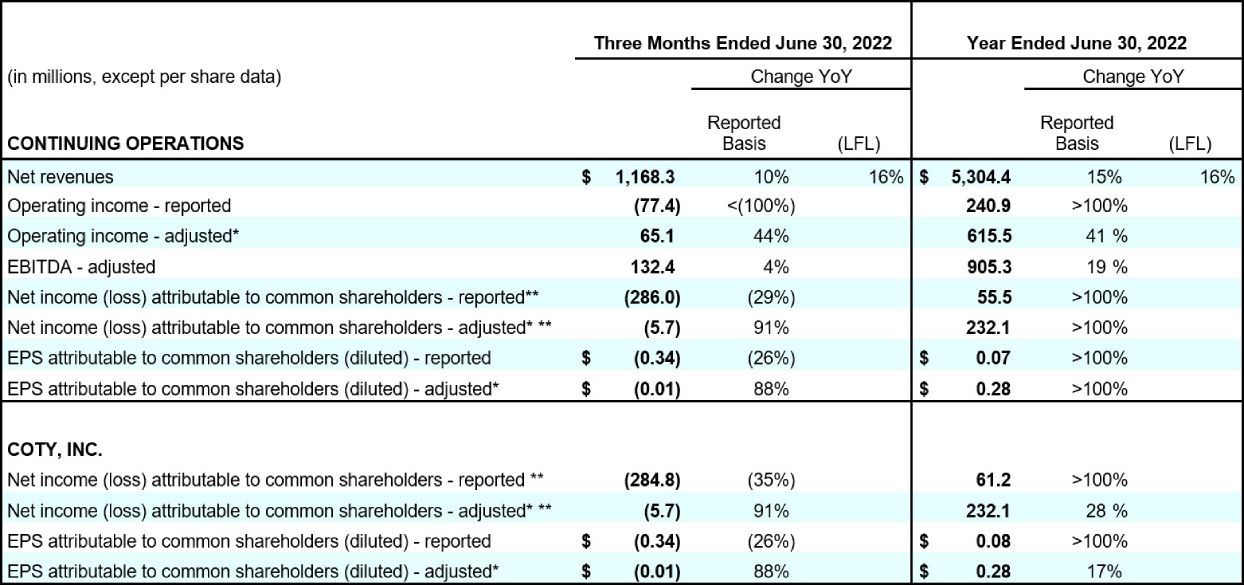
* These measures, as well as “free cash flow,” “adjusted earnings before interest, taxes, depreciation and amortization (adjusted EBITDA),” "immediate liquidity," “financial net debt,” and "economic net debt" are Non-GAAP Financial Measures. Refer to “Non-GAAP Financial Measures” for discussion of these measures. Reconciliations from reported to adjusted results can be found at the end of this release.
** Net income for Continuing Operations and Coty Inc. are net of the Convertible Series B Preferred Stock dividends.
FOURTH QUARTER BY SEGMENT (CONTINUING OPERATIONS)
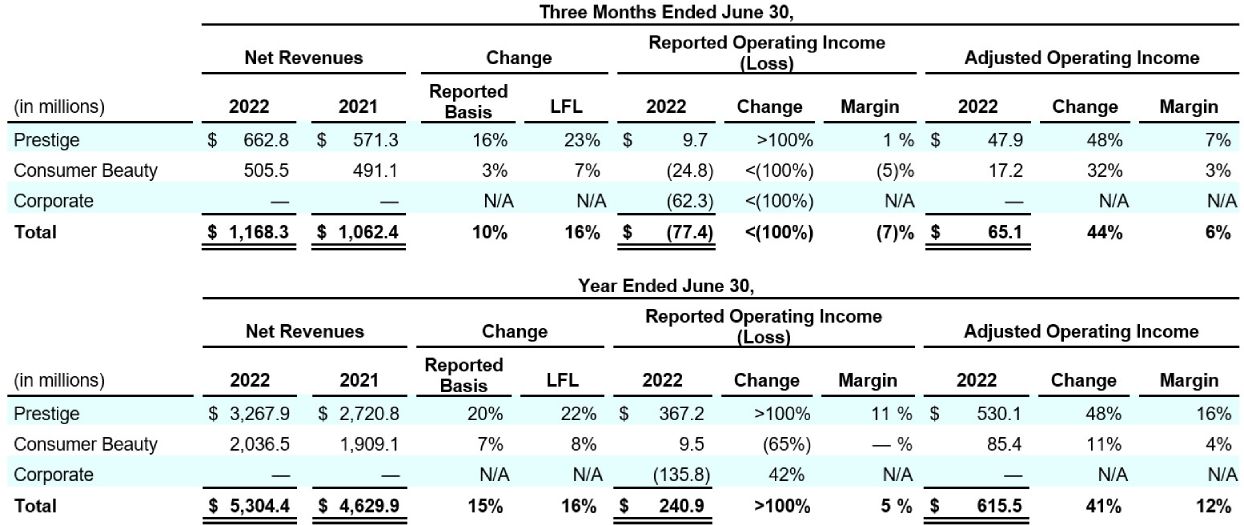
(a) As previously disclosed, we have realigned our reportable segments to a principally product category-based structure, comprised of a Prestige business segment and a Consumer Beauty business segment. In addition, we have amended the definition of stock compensation expense for use in certain Non-GAAP Financial Measures. In order to reflect these changes, the Company has recast reported net revenue by segment, reported operating income (loss) by segment, adjusted operating income (loss) by segment and total, adjusted EBITDA by segment, and total adjusted income (loss) before income taxes and total adjusted net income (loss) from continuing operations for all comparative periods shown.
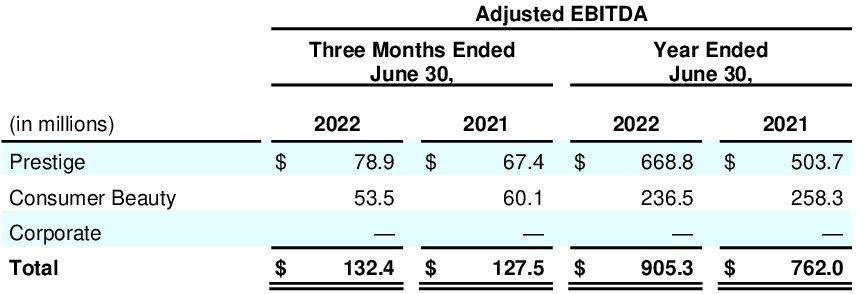
FOURTH QUARTER FISCAL 2022 BY REGION
Continuing Operations

COTY INC. & SUBSIDIARIES CONDENSED CONSOLIDATED STATEMENTS OF OPERATIONS

(a) Diluted EPS is adjusted by the effect of dilutive securities, including awards under the Company's equity compensation plans and the convertible Series B Preferred Stock. When calculating any potential dilutive effect of stock options, Series A Preferred Stock, restricted stock and RSUs, the Company uses the treasury method and the if-converted method for the Convertible Series B Preferred Stock. The treasury method typically does not adjust the net income attributable to Coty Inc., while the if-converted method requires an adjustment to reverse the impact of the preferred stock dividends, if dilutive, on net income applicable to common stockholders during the period.
(b) For the three months ended June 30, 2022 and 2021, and the twelve months ended June 30, 2021, stock options and Series A/A-1 Preferred Stock with purchase or conversion rights to purchase shares of Common Stock, RSUs and Convertible Series B Preferred Stock were excluded from the computation of diluted EPS due to the net loss incurred during the period. For the twelve months ended June 30, 2022, there were $75.3 million shares of outstanding stock options and Series A/A-1 Preferred Stock with purchase or conversion rights to purchase shares of Common Stock, RSUs and Convertible Series B Preferred Stock were excluded in the computation of adjusted weighted-average diluted shares because their effect would be anti-dilutive.
RECONCILIATION OF REPORTED TO ADJUSTED RESULTS FOR THE CONSOLIDATED STATEMENTS OF OPERATIONS
These supplemental schedules provide adjusted Non-GAAP financial information and a quantitative reconciliation of the difference between the Non-GAAP financial measure and the financial measure calculated and reported in accordance with GAAP.
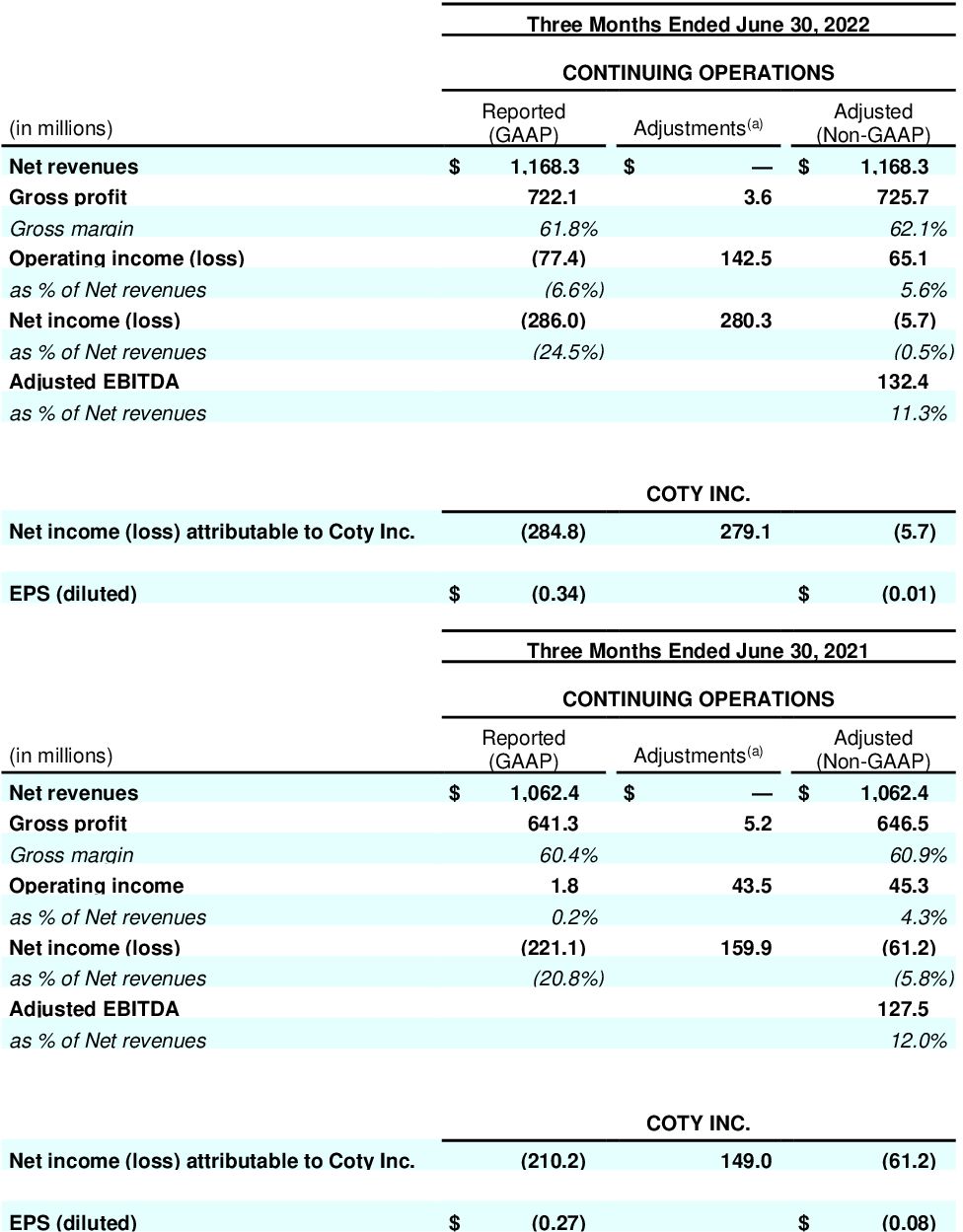
(a) See “Reconciliation of Reported Operating Income (Loss) to Adjusted Operated Income” and “Reconciliation of Reported Net (Loss) Income to Adjusted Net Income” for a detailed description of adjusted items.
RECONCILIATION OF REPORTED TO ADJUSTED RESULTS FOR THE CONSOLIDATED STATEMENTS OF OPERATIONS
These supplemental schedules provide adjusted Non-GAAP financial information and a quantitative reconciliation of the difference between the Non-GAAP financial measure and the financial measure calculated and reported in accordance with GAAP.
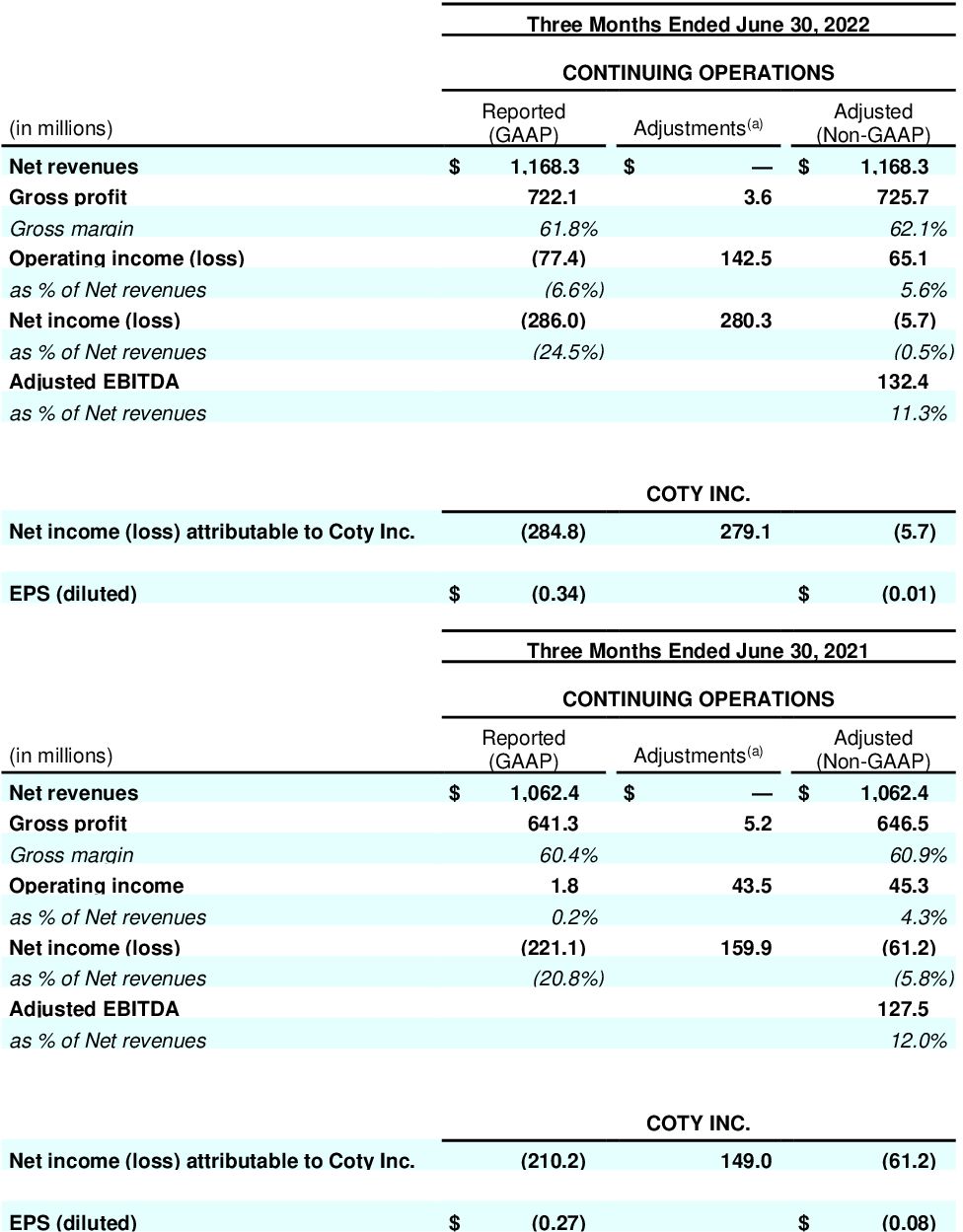
(a) See “Reconciliation of Reported Operating Income (Loss) to Adjusted Operated Income” and “Reconciliation of Reported Net (Loss) Income to Adjusted Net Income” for a detailed description of adjusted items.
RECONCILIATION OF REPORTED TO ADJUSTED RESULTS FOR THE CONSOLIDATED STATEMENTS OF OPERATIONS
These supplemental schedules provide adjusted Non-GAAP financial information and a quantitative reconciliation of the difference between the Non-GAAP financial measure and the financial measure calculated and reported in accordance with GAAP.
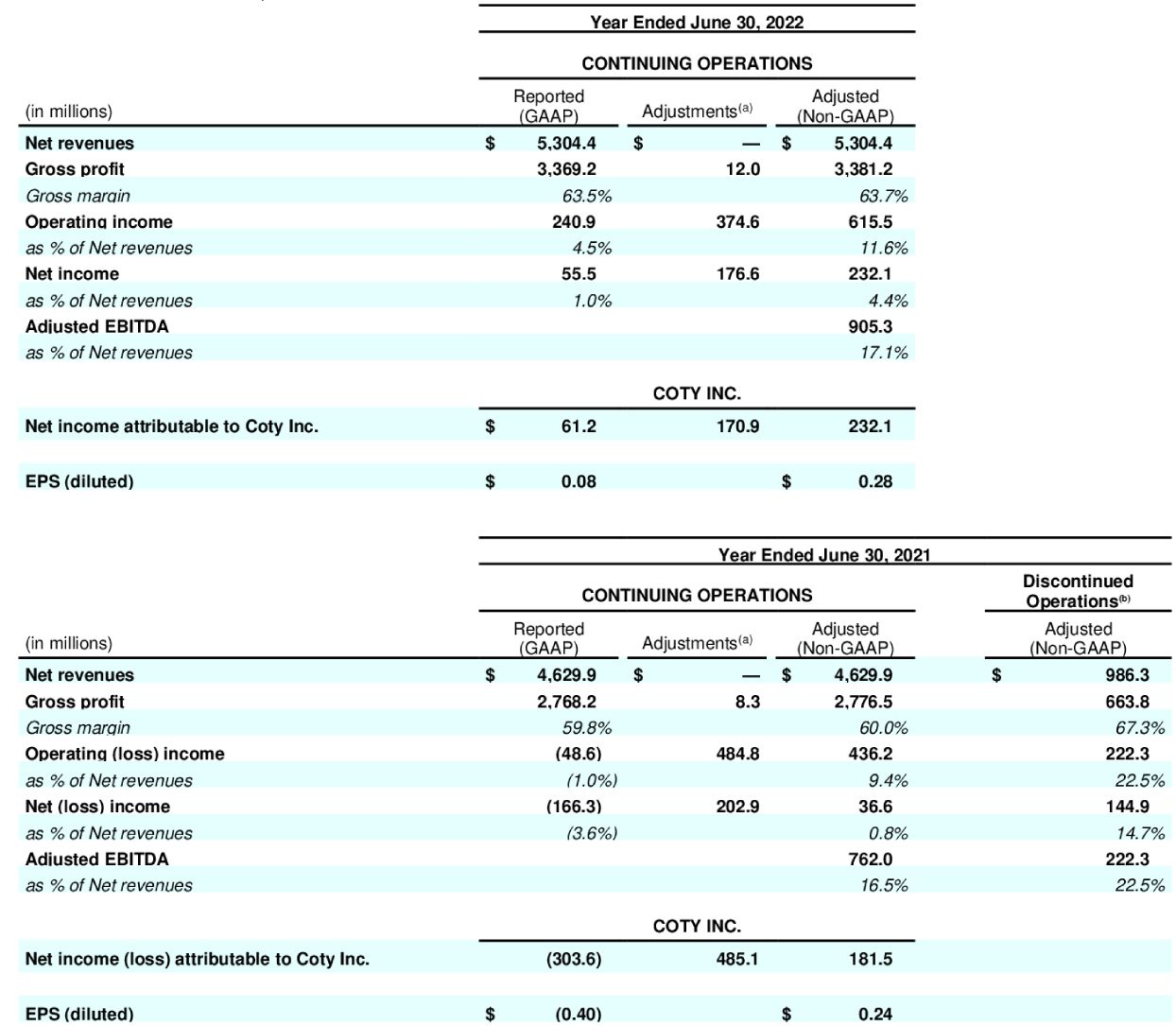
(a) See “Reconciliation of Reported Operating Income (Loss) to Adjusted Operated Income” and “Reconciliation of Reported Net (Loss) Income to Adjusted Net Income” for a detailed description of adjusted items.
(b) Discontinued operations for the fiscal year 2021 includes activity only through November 30, 2020, the date of the sale of the Wella Company.
RECONCILIATION OF REPORTED OPERATING INCOME (LOSS) TO ADJUSTED OPERATING INCOME AND ADJUSTED EBITDA
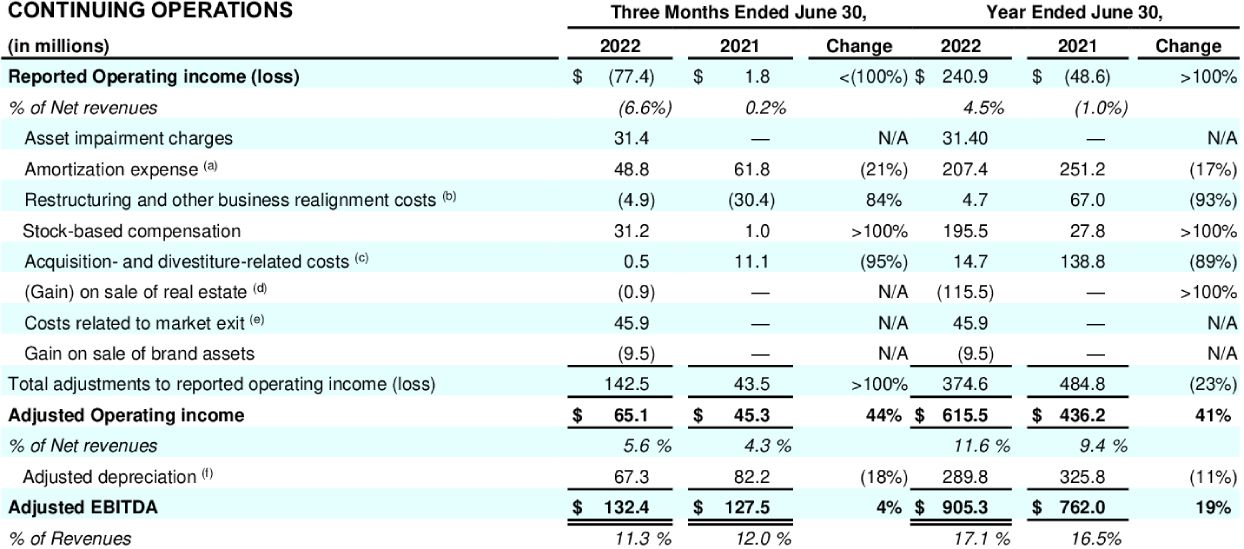
(a) In the three months ended June 30, 2022, amortization expense of $38.2 and $10.6 was reported in the Prestige and Consumer Beauty segments, respectively. In the three months ended June 30, 2021, amortization expense of $49.9 and $11.9 was reported in the Prestige and Consumer Beauty segments, respectively.
In fiscal 2022, amortization expense of $162.9 and $44.5 was reported in the Prestige and Consumer Beauty segments, respectively. In fiscal 2021, amortization expense of $201.2 and $50.0 was reported in the Prestige and Consumer Beauty segments, respectively.
(b) In the three months ended June 30, 2022, we incurred a credit in restructuring and other business structure realignment costs of $(4.9). We incurred a credit in restructuring costs of $(8.0) included in the Condensed Consolidated Statements of Operations, related to the Transformation Plan due to a change in estimate and $6.3 related to employee severances in connection with our exit of Russia and business structure realignment costs of $3.1 primarily related to the Transformation Plan and certain other programs. This amount includes $(0.1) reported in Selling, general and administrative expenses, and $3.2 reported in Cost of sales in the Condensed Consolidated Statement of Operations. In the three months ended June 30, 2021, we incurred a credit in restructuring and other business structure realignment costs of $(30.4). We incurred a credit in restructuring costs of $(26.1) primarily related to the Transformation Plan, included in the Condensed Consolidated Statements of Operations; and credit in business structure realignment costs of $(4.3) primarily related to the Transformation Plan and certain other programs. This amount includes $(9.5) reported in Selling, general and administrative expenses, and $5.2 reported in Cost of sales in the Condensed Consolidated Statement of Operations.
In fiscal 2022, we incurred restructuring and other business structure realignment costs of $4.7. We incurred a credit in restructuring costs of $(6.5) included in the Condensed Consolidated Statements of Operations, related to the Transformation Plan due to a change in estimate and $6.3 related to employee severances in connection with our exit of Russia and business structure realignment costs of $11.2 primarily related to the Transformation Plan and certain other programs. This amount includes $(0.4) reported in Selling, general and administrative expenses, and $11.6 reported in Cost of sales in the Condensed Consolidated Statement of Operations. In fiscal 2021, we incurred restructuring and other business structure realignment costs of $67.0. We incurred restructuring costs of $63.6 primarily related to the Transformation Plan, included in the Condensed Consolidated Statements of Operations; and business structure realignment costs of $3.4 primarily related to the Transformation Plan and certain other programs. This amount includes $(4.9) reported in Selling, general and administrative expenses, and $8.3 reported in Cost of sales in the Condensed Consolidated Statement of Operations.
(c) In the three months ended June 30, 2022 and June 30, 2021, we incurred acquisition- and divestiture-related costs of $0.5 and $11.1, respectively. These costs were primarily associated with the Wella Company Transaction.
In fiscal 2022 and 2021, we incurred acquisition- and divestiture-related costs of $14.7 and $138.8, respectively. These costs were primarily associated with the Wella Company Transaction.
(d) In the three months ended June 30, 2022, we recognized a gain of $0.9 related to sale of real estate. In the three months ended June 30, 2021, we did not recognize any gain related to sale of real estate.
In fiscal 2022, we recognized a gain of $115.5 related to sale of real estate. In fiscal 2021, we did not recognize any gain related to sale of real estate.
(e) In fiscal 2022, we incurred $45.9 of costs related to our decision to wind down our business operations in Russia which are included in Selling, general and administrative expenses and Cost of sales in the Consolidated Statements of Operations. These charges consisted of $45.5 in Selling, general and administrative expenses, primarily related to the write-down of working capital, long-term assets, as well as contract termination charges, contingent liabilities and legal costs and $0.4 in Cost of sales related to inventory write-downs.
In fiscal 2021 and 2020, we did not recognize costs related to a market exit.
(f) In the three months ended June 30, 2022, adjusted depreciation expense of $31.0 and $36.3 was reported in the Prestige and Consumer Beauty segments, respectively. In the three months ended June 30, 2021, adjusted depreciation expense of $35.1 and $47.1 was reported in the Prestige and Consumer Beauty segments, respectively.
In fiscal 2022, adjusted depreciation expense of $138.7 and $151.1 was reported in the Prestige and Consumer Beauty segments, respectively. In fiscal 2021, adjusted depreciation expense of $144.4 and $181.4 was reported in the Prestige and Consumer Beauty segments, respectively.
RECONCILIATION OF REPORTED INCOME (LOSS) BEFORE INCOME TAXES AND EFFECTIVE TAX RATES TO ADJUSTED INCOME BEFORE INCOME TAXES AND ADJUSTED EFFECTIVE TAX RATES FOR CONTINUING OPERATIONS

The adjusted effective tax rate was 97.6% for the three months ended June 30, 2022 compared to (11.9%) for the three months ended June 30, 2021. The differences were primarily due to a valuation allowance recorded in the current period.

(a) See a description of adjustments under “Adjusted Operating Income (Loss) for Continuing Operations.”
(b) The tax effects of each of the items included in adjusted income are calculated in a manner that results in a corresponding income tax expense/provision for adjusted income. In preparing the calculation, each adjustment to reported income is first analyzed to determine if the adjustment has an income tax consequence. The provision for taxes is then calculated based on the jurisdiction in which the adjusted items are incurred, multiplied by the respective statutory rates and offset by the increase or reversal of any valuation allowances commensurate with the non-GAAP measure of profitability. In connection with our decision to wind down our operations in Russia, we recognized tax charges related to certain direct incremental impacts of our decision, which are reflected in this amount, in fiscal 2022.
(c) The amount represents the realized and unrealized loss (gain) recognized for the change in the fair value of the investment in Wella Company.
(d) For the three months ended June 30, 2022, this primarily represents a net gain on the exchange of Series B Preferred Stock closed on October 20, 2021. For the three months ended June 30, 2021, this primarily represents the write-off of deferred financing fees related to the Wella Company sale.
For the year ended June 30, 2022, this primarily represents a net gain on the exchange of Series B Preferred Stock closed on October 20, 2021. For the year ended June 30, 2021, this primarily represents the write-off of deferred financing fees related to the Wella Company sale and adjustments for pension curtailment gains.
(e) The total tax impact on adjustments in the prior period includes a $234.4 benefit recorded as the result of the tax rate differential on the deferred taxes recognized on the transfer of assets and liabilities, following the relocation of our main principal location from Geneva to Amsterdam on July 1, 2020. It also includes a $130.0 tax expense recorded as the result of an internal restructuring following the Wella Company divestiture, primarily intended to create a more efficient structure to hold its remaining equity investment in Wella Company.
(f) The total tax impact on adjustments in the current period includes a tax expense of $24.1 recorded as the result of the Company's exit from Russia.
RECONCILIATION OF REPORTED NET INCOME TO ADJUSTED NET INCOME FOR CONTINUING OPERATIONS
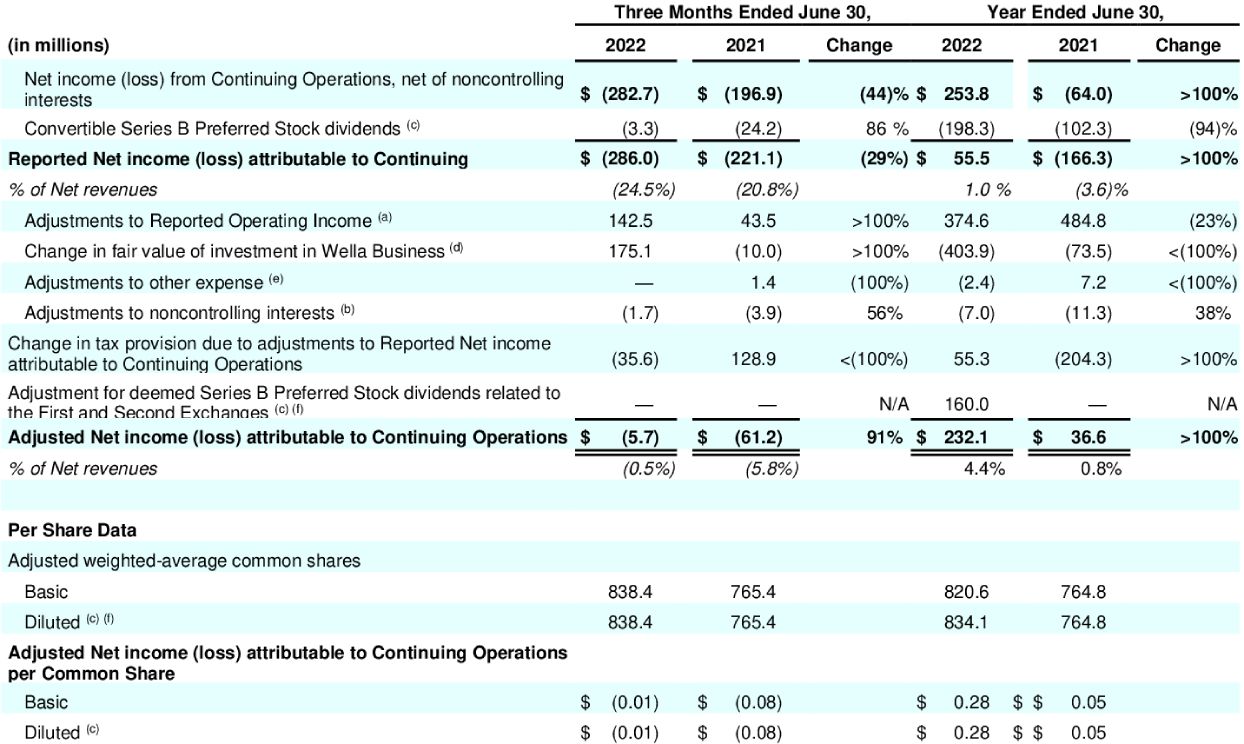
(a) See a description of adjustments under “Adjusted Operating Income (Loss) for Continuing Operations.”
(b) The amounts represent the after-tax impact of the non-GAAP adjustments included in Net income attributable to noncontrolling interest based on the relevant noncontrolling interest percentage in the Condensed Consolidated Statements of Operations.
(c) Adjusted Diluted EPS is adjusted by the effect of dilutive securities, including awards under the Company's equity compensation plans and the convertible Series B Preferred Stock. When calculating any potential dilutive effect of stock options, Series A Preferred Stock, restricted stock and RSUs, the Company uses the treasury method and the if-converted method for the Convertible Series B Preferred Stock. The treasury method typically does not adjust the net income attributable to Coty Inc., while the if-converted method requires an adjustment to reverse the impact of the preferred stock dividends, if dilutive,, on net income applicable to common stockholders during the period.
(d) The amount represents the realized and unrealized gain recognized for the change in the fair value of the investment in Wella Company.
(e) For the three months ended June 30, 2021, this primarily represents the write-off of deferred financing fees related to the Wella Company sale.
For the twelve months ended June 30, 2022, this primarily represents a net gain on the exchange of Series B Preferred Stock closed on October 20, 2021. For the fiscal year ended June 30, 2022, this primarily represents the write-off of deferred financing fees related to the Wella Company sale and adjustments for pension curtailment gains.
(f) For the twelve months ended June 30, 2022, this adjustment represents the deemed dividend from the Second Exchange that closed on November 30, 2021 and the deemed dividend from the First Exchange that closed on October 20, 2021.
RECONCILIATION OF REPORTED NET INCOME (LOSS) TO ADJUSTED NET INCOME FOR COTY INC.
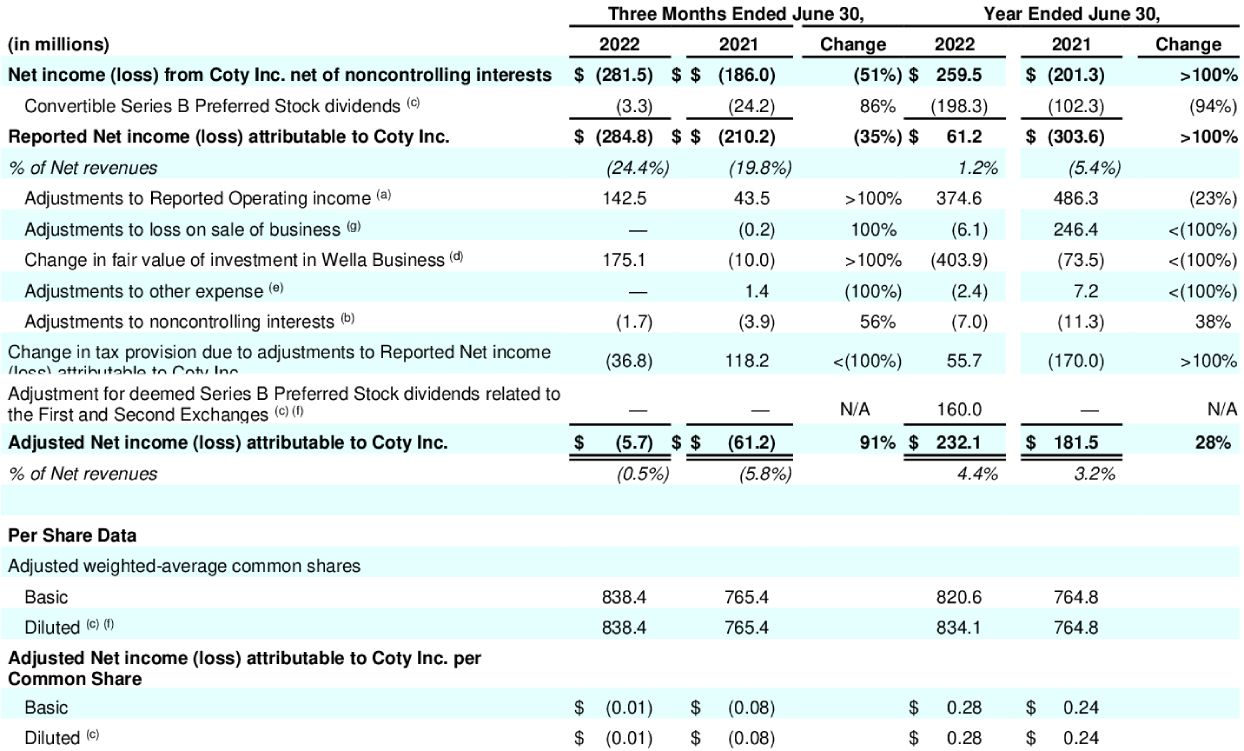
(a) See a description of adjustments under “Adjusted Operating Income (loss) for Coty Inc.”
(b) The amounts represent the after-tax impact of the non-GAAP adjustments included in Net income attributable to noncontrolling interest based on the relevant noncontrolling interest percentage in the Condensed Consolidated Statements of Operations.
(c) Adjusted Diluted EPS is adjusted by the effect of dilutive securities, including awards under the Company's equity compensation plans and the convertible Series B Preferred Stock. When calculating any potential dilutive effect of stock options, Series A Preferred Stock, restricted stock and RSUs, the Company uses the treasury method and the if-converted method for the Convertible Series B Preferred Stock. The treasury method typically does not adjust the net income attributable to Coty Inc., while the if-converted method requires an adjustment to reverse the impact of the preferred stock dividends, if dilutive,, on net income applicable to common stockholders during the period.
(d) The amount represents the realized and unrealized gain recognized for the change in the fair value of the investment in Wella Company.
(e) For the three months ended June 30, 2021, this primarily represents the write-off of deferred financing fees related to the Wella Company sale.
For the twelve months ended June 30, 2022, this primarily represents a net gain on the exchange of Series B Preferred Stock closed on October 20, 2021. For the fiscal year ended June 30, 2022, this primarily represents the write-off of deferred financing fees related to the Wella Company sale and adjustments for pension curtailment gains.
(f) For the twelve months ended June 30, 2022, this adjustment represents the deemed dividend from the Second Exchange that closed on November 30, 2021 and the deemed dividend from the First Exchange that closed on October 20, 2021.
(g) This amount reflects certain working capital adjustments related to the sale of the Wella Company.
RECONCILIATION OF NET CASH PROVIDED BY OPERATING ACTIVITIES TO FREE CASH FLOW

RECONCILIATION OF TOTAL DEBT TO ECONOMIC NET DEBT

IMMEDIATE LIQUIDITY

RECONCILIATION OF ADJUSTED OPERATING INCOME TO ADJUSTED EBITDA

(a) For a reconciliation of adjusted operating income (loss) to operating income (loss) for continuing operations for the period, see the table entitled “Reconciliation of Reported Operating Income (loss) to Adjusted Operating Income for Continuing Operations” for the period.
(b) Adjusted depreciation for the twelve months ended June 30, 2022 represents depreciation expense for continuing operations for the period, excluding accelerated depreciation.
FINANCIAL NET DEBT/ADJUSTED EBITDA

RECONCILIATION OF REPORTED NET REVENUES TO LIKE-FOR-LIKE NET REVENUES
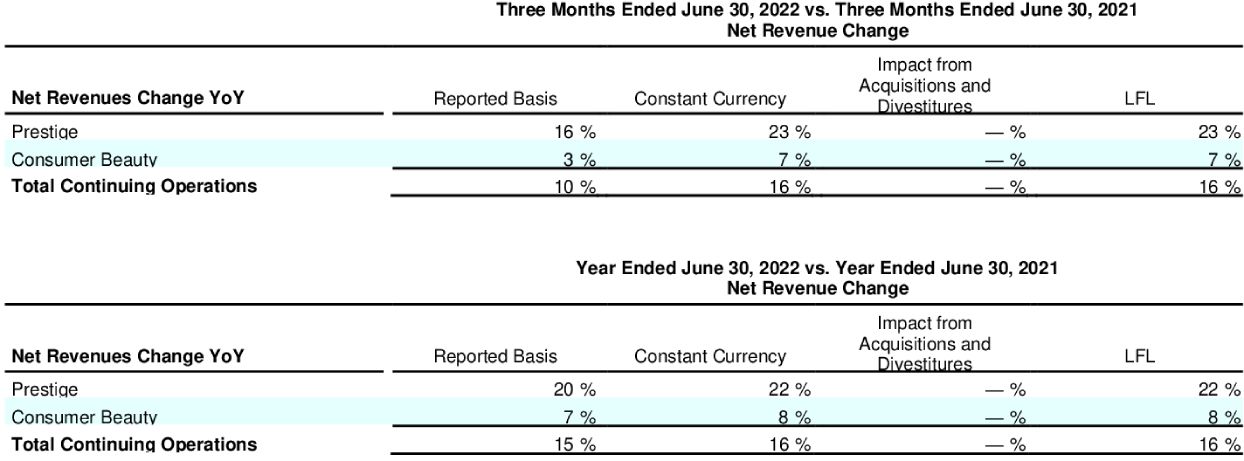
COTY INC. & SUBSIDIARIES CONDENSED CONSOLIDATED BALANCE SHEETS
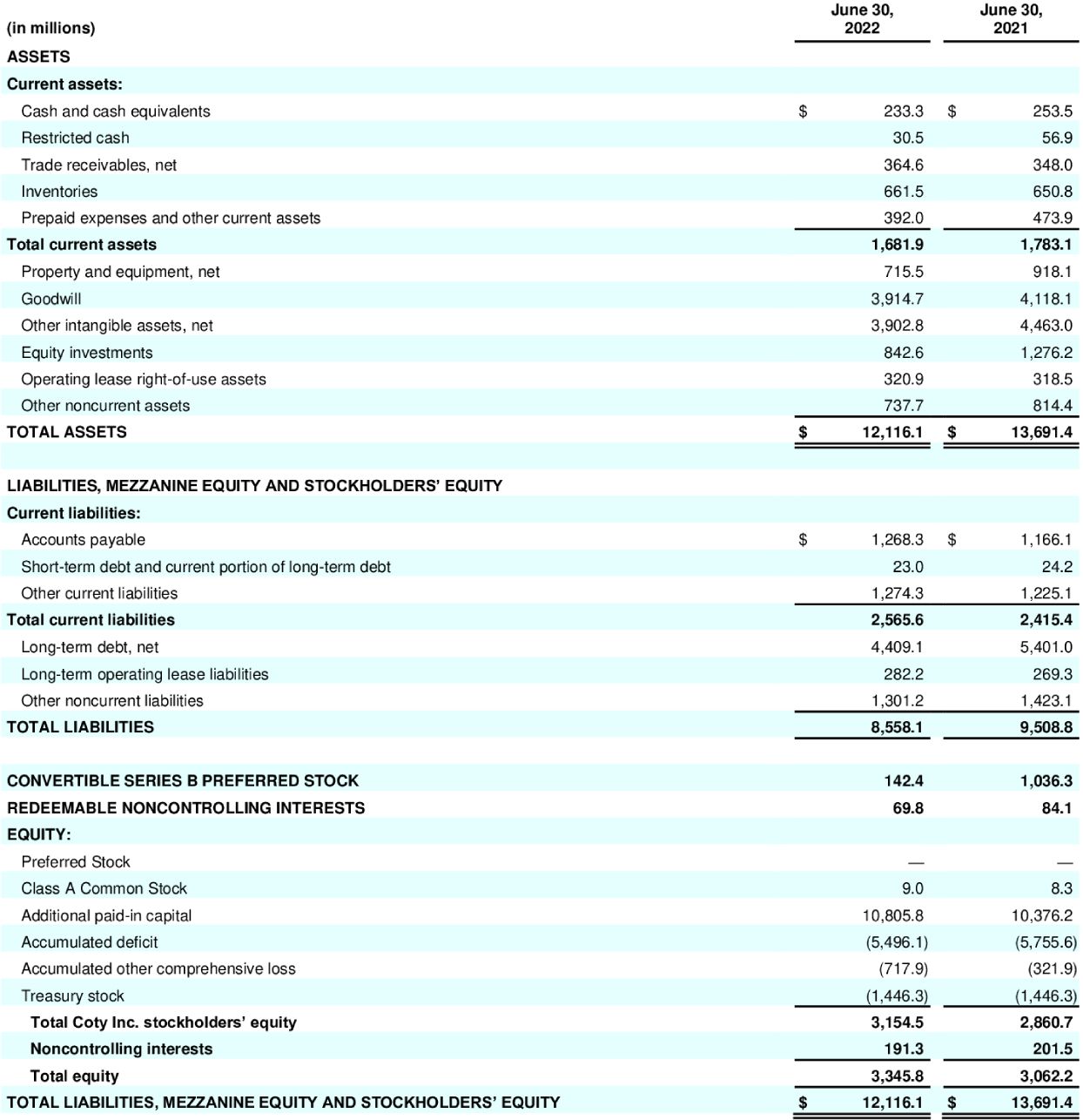
COTY INC. & SUBSIDIARIES CONDENSED CONSOLIDATED STATEMENTS OF CASH FLOWS
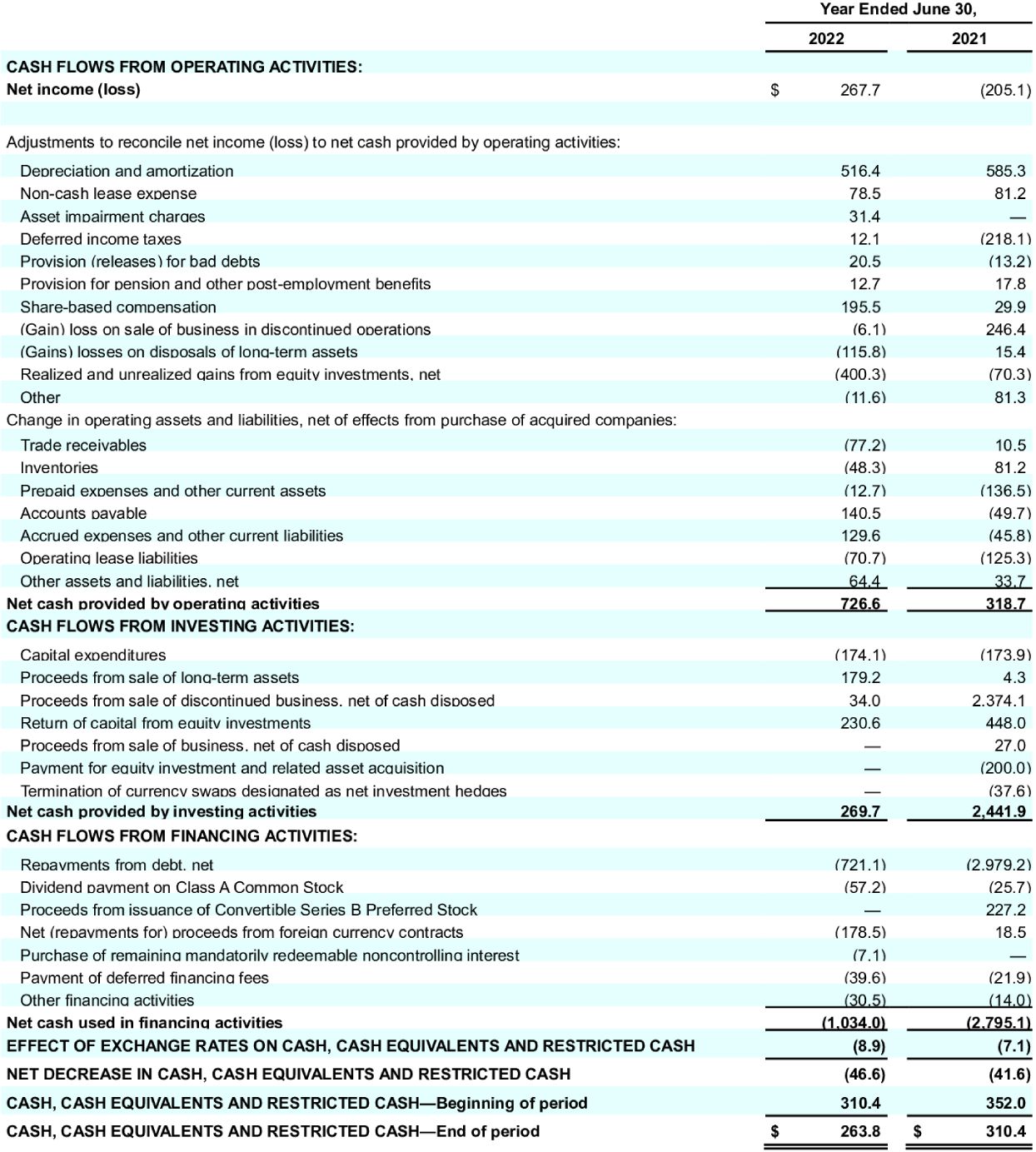
About Coty Inc.
Founded in Paris in 1904, Coty is one of the world’s largest beauty companies with a portfolio of iconic brands across fragrance, color cosmetics, and skin and body care. Coty serves consumers around the world, selling prestige and mass market products in approximately 125 countries and territories. Coty and our brands empower people to express themselves freely, creating their own visions of beauty; and we are committed to making a positive impact on the planet. Learn more at coty.com or on LinkedIn and Instagram.
Forward Looking Statements
Certain statements in this Earnings Release are “forward-looking statements” within the meaning of the Private Securities Litigation Reform Act of 1995. These forward-looking statements reflect the Company's current views with respect to, among other things, the impact of COVID-19 and potential recovery scenarios, strategic planning, targets and outlook for future reporting periods (including the extent and timing of revenue, expense and profit trends and changes in operating cash flows and cash flows from operating activities and investing activities), the wind down of the Company’s operations in Russia (including timing and expected impact), the Company’s future operations and strategy (including the expected implementation and related impact of its strategic priorities), ongoing and future cost efficiency, optimization and restructuring initiatives and programs, strategic transactions (including their expected timing and impact), expectations and/or plans with respect to joint ventures (including Wella Company and the timing and size of any related distribution or return of capital), the Company’s capital allocation strategy and payment of dividends (including suspension of dividend payments and the duration thereof and any plans to resume cash dividends on common stock or to continue to pay dividends in cash on preferred stock), investments, licenses and portfolio changes, product launches, relaunches or rebranding (including the expected timing or impact thereof), synergies, savings, performance, cost, timing and integration of acquisitions, including the strategic partnerships with Kylie Jenner and Kim Kardashian West, future cash flows, liquidity and borrowing capacity (including any refinancing or deleveraging activities), timing and size of cash outflows and debt deleveraging, the timing and extent of any future impairments, and synergies, savings, impact, cost, timing and implementation of the Company’s ongoing transformation agenda (including operational and organizational structure changes, operational execution and simplification initiatives, fixed cost reductions and supply chain changes), expected impact, cost, timing and implementation of e-commerce and digital initiatives, expected impact, cost, timing and implementation of sustainability initiatives (including progress, plans and goals), the expected impact of geopolitical risks including the ongoing war in Ukraine on our business operations, sales outlook and strategy, the expected impact of global supply chain challenges and/or inflationary pressures (including as a result of COVID-19 and/or the war in Ukraine), and the priorities of senior management. These forward-looking statements are generally identified by words or phrases, such as “anticipate”, “are going to”, “estimate”, “plan”, “project”, “expect”, “believe”, “intend”, “foresee”, “forecast”, “will”, “may”, “should”, “outlook”, “continue”, “temporary”, “target”, “aim”, “potential”, “goal” and similar words or phrases. These statements are based on certain assumptions and estimates that we consider reasonable, but are subject to a number of risks and uncertainties, many of which are beyond our control, which could cause actual events or results (including our financial condition, results of operations, cash flows and prospects) to differ materially from such statements, including risks and uncertainties relating to:
- the impact of COVID-19 (or future similar events), including demand for the Company’s products, illness, quarantines, government actions, facility closures, store closures or other restrictions in connection with the COVID-19 pandemic, and the extent and duration thereof, the availability and widespread distribution of effective vaccines, related impact on the Company's ability to meet customer needs and on the ability of third parties on which the Company relies, including its suppliers, customers, contract manufacturers, distributors, contractors, commercial banks and joint-venture partners, to meet their obligations to the Company, in particular collections from customers, the extent that government funding and reimbursement programs in connection with COVID-19 are available to the Company, and the ability to successfully implement measures to respond to such impacts;
- the Company’s ability to successfully implement its multi-year Transformation Plan, including its management realignment, reporting structure changes, operational and organizational changes, and the initiatives to further reduce the Company’s cost base, and to develop and achieve its global business strategies (including mix management, select price increases, more disciplined promotions, and foregoing low value sales), compete effectively in the beauty industry, achieve the benefits contemplated by its strategic initiatives (including revenue growth, cost control, gross margin growth and debt deleveraging) and successfully implement its strategic priorities (including stabilizing its consumer beauty brands through leading innovation and improved execution, accelerating its prestige fragrance brands and ongoing expansion into prestige cosmetics, building a comprehensive skincare portfolio, enhancing its e-commerce and direct-to-consumer (“DTC”) capabilities, expanding its presence in China through prestige products and select consumer beauty brands, and establishing Coty as an industry leader in sustainability) in each case within the expected time frame or at all;
- the Company’s ability to anticipate, gauge and respond to market trends and consumer preferences, which may change rapidly, and the market acceptance of new products, including new products related to Kylie Jenner’s or Kim Kardashian West’s existing beauty businesses, any relaunched or rebranded products and the anticipated costs and discounting associated with such relaunches and rebrands, and consumer receptiveness to our current and future marketing philosophy and consumer engagement activities (including digital marketing and media);
- use of estimates and assumptions in preparing the Company’s financial statements, including with regard to revenue recognition, income taxes (including the expected timing and amount of the release of any tax valuation allowance), the assessment of goodwill, other intangible and long-lived assets for impairments, the market value of inventory, the fair value of the equity investment, and the fair value of acquired assets and liabilities associated with acquisitions;
- the impact of any future impairments;
- managerial, transformational, operational, regulatory, legal and financial risks, including diversion of management attention to and management of cash flows, expenses and costs associated with the Company's response to COVID-19, the Company's transformation agenda, the Company's global business strategies, the integration of the strategic partnerships with Kylie Jenner and Kim Kardashian West, and future strategic initiatives, and, in particular, the Company's ability to manage and execute many initiatives simultaneously including any resulting complexity, employee attrition or diversion of resources;
- the timing, costs and impacts of divestitures and the amount and use of proceeds from any such transactions;
- future divestitures and the impact thereof on, and future acquisitions, new licenses and joint ventures and the integration thereof with, our business, operations, systems, financial data and culture and the ability to realize synergies, manage supply chain challenges and avoid future supply chain and other business disruptions, reduce costs (including through the Company’s cash efficiency initiatives), avoid liabilities and realize potential efficiencies and benefits (including through our restructuring initiatives) at the levels and at the costs and within the time frames contemplated or at all;
- increased competition, consolidation among retailers, shifts in consumers’ preferred distribution and marketing channels (including to digital and prestige channels), distribution and shelf-space resets or reductions, compression of go-to-market cycles, changes in product and marketing requirements by retailers, reductions in retailer inventory levels and order lead-times or changes in purchasing patterns, impact from COVID-19 on retail revenues, and other changes in the retail, e-commerce and wholesale environment in which the Company does business and sells its products and the Company’s ability to respond to such changes (including its ability to expand its digital, direct-to-consumer and e-commerce capabilities within contemplated timeframes or at all);
- the Company and its joint ventures’, business partners’ and licensors’ abilities to obtain, maintain and protect the intellectual property used in its and their respective businesses, protect its and their respective reputations (including those of its and their executives or influencers), public goodwill, and defend claims by third parties for infringement of intellectual property rights;
- any change to the Company’s capital allocation and/or cash management priorities, including any change in the Company’s dividend policy or, if the Company's Board declares dividends, the Company’s stock dividend reinvestment program;
- any unanticipated problems, liabilities or integration or other challenges associated with a past or future acquired business, joint ventures or strategic partnerships which could result in increased risk or new, unanticipated or unknown liabilities, including with respect to environmental, competition and other regulatory, compliance or legal matters, and specifically in connection with the strategic partnerships with Kylie Jenner and Kim Kardashian West, risks related to the entry into a new distribution channel, the potential for channel conflict, risks of retaining customers and key employees, difficulties of integration (or the risks associated with limiting integration),ability to protect trademarks and brand names, litigation or investigations by governmental authorities, and changes in law, regulations and policies that affect KKW Holdings, LLC’s (“KKW Holdings”) business or products, including risk that direct selling laws and regulations may be modified, interpreted or enforced in a manner that results in a negative impact to KKW Holdings’ business model, revenue, sales force or business;
- the Company’s international operations and joint ventures, including enforceability and effectiveness of its joint venture agreements and reputational, compliance, regulatory, economic and foreign political risks, including difficulties and costs associated with maintaining compliance with a broad variety of complex local and international regulations;
- the Company’s dependence on certain licenses (especially in the fragrance category) and the Company’s ability to renew expiring licenses on favorable terms or at all;
- the Company’s dependence on entities performing outsourced functions, including outsourcing of distribution functions, and third-party manufacturers, logistics and supply chain suppliers, and other suppliers, including third-party software providers, web-hosting and e-commerce providers;
- administrative, product development and other difficulties in meeting the expected timing of market expansions, product launches and re-launches and marketing efforts, including in connection with new products related to Kylie Jenner’s or Kim Kardashian West’s existing beauty businesses or new products related to Orveda;
- global political and/or economic uncertainties, disruptions or major regulatory or policy changes, and/or the enforcement thereof that affect the Company’s business, financial performance, operations or products, including the impact of the war in Ukraine and any related escalation or expansion thereof, Brexit (and related business or market disruption), upcoming elections in Brazil, the current U.S. administration and upcoming mid-term elections, changes in the U.S. tax code, and recent changes and future changes in tariffs, retaliatory or trade protection measures, trade policies and other international trade regulations in the U.S., the European Union and Asia and in other regions where the Company operates; recent and future changes in sanctions regulations including in connection with the war in Ukraine and any escalation or expansion thereof;
- currency exchange rate volatility and currency devaluation and/or inflation;
- the number, type, outcomes (by judgment, order or settlement) and costs of current or future legal, compliance, tax, regulatory or administrative proceedings, investigations and/or litigation, including litigation relating to the tender offer by Cottage Holdco B.V. (the “Cottage Tender Offer”) and product liability cases (including asbestos and talc-related litigation for which indemnities and/or insurance may not be available), distributor or licensor litigation, and compliance, litigation or investigations relating to our joint ventures and strategic partnerships;
- the Company’s ability to manage seasonal factors and other variability and to anticipate future business trends and needs;
- disruptions in operations, sales and in other areas, including due to disruptions in our supply chain, restructurings and other business alignment activities, manufacturing or information technology systems, labor disputes, extreme weather and natural disasters, impact from COVID-19 or similar global public health events, the outbreak of war or hostilities (including the war in Ukraine and any escalation or expansion thereof), impact of global supply chain challenges, and the impact of such disruptions on the Company’s ability to generate profits, stabilize or grow revenues or cash flows, comply with its contractual obligations and accurately forecast demand and supply needs and/or future results;
- restrictions imposed on the Company through its license agreements, credit facilities and senior unsecured bonds or other material contracts, its ability to generate cash flow to repay, refinance or recapitalize debt and otherwise comply with its debt instruments, and changes in the manner in which the Company finances its debt and future capital needs;
- increasing dependency on information technology, including as a result of remote working in response to COVID-19, and the Company’s ability to protect against service interruptions, data corruption, cyber-based attacks or network security breaches, including ransomware attacks, costs and timing of implementation and effectiveness of any upgrades or other changes to information technology systems, and the cost of compliance or the Company’s failure to comply with any privacy or data security laws (including the European Union General Data Protection Regulation, the California Consumer Privacy Act and similar state laws, the Brazil General Data Protection Law and the China Data Security Law and Personal Information Protection Law) or to protect against theft of customer, employee and corporate sensitive information;
- the Company's ability to attract and retain key personnel and the impact of senior management transitions and organizational structure changes;
- the distribution and sale by third parties of counterfeit and/or gray market versions of the Company’s products;
- the impact of the Transformation Plan as well as the Wella Transaction on the Company’s relationships with key customers and suppliers and certain material contracts;
- the Company’s relationship with Cottage Holdco B.V., as the Company’s majority stockholder, and its affiliates, and any related conflicts of interest or litigation;
- the Company’s relationship with KKR, whose affiliate KKR Bidco is an investor in the Wella Company, and any related conflicts of interest or litigation;
- future sales of a significant number of shares by the Company’s majority stockholder or the perception that such sales could occur; and
- other factors described elsewhere in this document and in documents that the Company files with the SEC from time to time.
When used herein, the term “includes” and “including” means, unless the context otherwise indicates, “including without limitation”. More information about potential risks and uncertainties that could affect the Company’s business and financial results is included under the heading “Risk Factors” and “Management’s Discussion and Analysis of Financial Condition and Results of Operations” in the Company’s Quarterly Report on Form 10-Q for the period ended March 31, 2022 and annual report on Form 10-K for the year ended June 30, 2022 and other periodic reports the Company has filed and may file with the SEC from time to time.
All forward-looking statements made in this release are qualified by these cautionary statements. These forward-looking statements are made only as of the date of this release, and the Company does not undertake any obligation, other than as may be required by applicable law, to update or revise any forward-looking or cautionary statements to reflect changes in assumptions, the occurrence of events, unanticipated or otherwise, or changes in future operating results over time or otherwise.
Comparisons of results for current and any prior periods are not intended to express any future trends or indications of future performance unless expressed as such, and should only be viewed as historical data.
Non-GAAP Financial Measures
The Company operates on a global basis, with the majority of net revenues generated outside of the U.S. Accordingly, fluctuations in foreign currency exchange rates can affect results of operations. Therefore, to supplement financial results presented in accordance with GAAP, certain financial information is presented excluding the impact of foreign currency exchange translations to provide a framework for assessing how the underlying businesses performed excluding the impact of foreign currency exchange translations (“constant currency”). Constant currency information compares results between periods as if exchange rates had remained constant period-over-period, with the current period’s results calculated at the prior-year period’s rates. The Company calculates constant currency information by translating current and prior-period results for entities reporting in currencies other than U.S. dollars into U.S. dollars using constant foreign currency exchange rates. The constant currency calculations do not adjust for the impact of revaluing specific transactions denominated in a currency that is different to the functional currency of that entity when exchange rates fluctuate. The constant currency information presented may not be comparable to similarly titled measures reported by other companies. The Company discloses the following constant currency financial measures: net revenues, organic like-for-like (LFL) net revenues, adjusted gross profit and adjusted operating income.
The Company presents period-over-period comparisons of net revenues on a constant currency basis as well as on an organic (LFL) basis. The Company believes that organic (LFL) better enables management and investors to analyze and compare the Company's net revenues performance from period to period. For the periods described in this release, the term “like-for-like” describes the Company's core operating performance, excluding the financial impact of (i) acquired brands or businesses in the current year period until we have twelve months of comparable financial results, (ii) the divested brands or businesses or early terminated brands, generally, in the prior year non-comparable periods, to maintain comparable financial results with the current fiscal year period and (iii) foreign currency exchange translations to the extent applicable. For a reconciliation of organic (LFL) period-over-period, see the table entitled “Reconciliation of Reported Net Revenues to Like-For-Like Net Revenues”.
The Company presents operating income, operating income margin, gross profit, gross margin, effective tax rate, net income, net income margin, net revenues, EBITDA, and EPS (diluted) on a non-GAAP basis and specifies that these measures are non-GAAP by using the term “adjusted” (collectively the Adjusted Performance Measures). The reconciliations of these non-GAAP financial measures to the most directly comparable financial measures calculated and presented in accordance with GAAP are shown in tables below. These non-GAAP financial measures should not be considered in isolation from, or as a substitute for or superior to, financial measures reported in accordance with GAAP. Moreover, these non-GAAP financial measures have limitations in that they do not reflect all the items associated with the operations of the business as determined in accordance with GAAP. Other companies, including companies in the beauty industry, may calculate similarly titled non-GAAP financial measures differently than we do, limiting the usefulness of those measures for comparative purposes.
Adjusted operating income/Adjusted EBITDA from continuing operations excludes restructuring costs and business structure realignment programs, amortization, acquisition- and divestiture-related costs and acquisition accounting impacts, stock-based compensation, and asset impairment charges and other adjustments as described below. For adjusted EBITDA, in addition to the preceding, we exclude adjusted depreciation as defined below. We do not consider these items to be reflective of our core operating performance due to the variability of such items from period-to-period in terms of size, nature and significance. They are primarily incurred to realign our operating structure and integrate new acquisitions, and implement divestitures of components of our business, and fluctuate based on specific facts and circumstances. Additionally, Adjusted net income attributable to Coty Inc. and Adjusted net income attributable to Coty Inc. per common share are adjusted for certain interest and other (income) expense items and preferred stock deemed dividends, as described below, and the related tax effects of each of the items used to derive Adjusted net income as such charges are not used by our management in assessing our operating performance period-to-period.
Adjusted Performance Measures reflect adjustments based on the following items:
- Costs related to acquisition and divestiture activities: The Company excludes acquisition- and divestiture-related costs and the accounting impacts such as those related to transaction costs and costs associated with the revaluation of acquired inventory in connection with business combinations because these costs are unique to each transaction. Additionally, for divestitures, the Company excludes write-offs of assets that are no longer recoverable and contract related costs due to the divestiture. The nature and amount of such costs vary significantly based on the size and timing of the acquisitions and divestitures, and the maturities of the businesses being acquired or divested. Also, the size, complexity and/or volume of past transactions, which often drives the magnitude of such expenses, may not be indicative of the size, complexity and/or volume of any future acquisitions or divestitures.
- Restructuring and other business realignment costs: The Company excludes costs associated with restructuring and business structure realignment programs to allow for comparable financial results to historical operations and forward-looking guidance. In addition, the nature and amount of such charges vary significantly based on the size and timing of the programs. By excluding the referenced expenses from the non-GAAP financial measures, management is able to further evaluate the Company’s ability to utilize existing assets and estimate their long-term value. Furthermore, management believes that the adjustment of these items supplement the GAAP information with a measure that can be used to assess the sustainability of the Company’s operating performance.
- Asset impairment charges: The Company excludes the impact of asset impairments as such non-cash amounts are inconsistent in amount and frequency and are significantly impacted by the timing and/or size of acquisitions. Our management believes that the adjustment of these items supplement the GAAP information with a measure that can be used to assess the sustainability of our operating performance.
- Amortization expense: We have excluded the impact of amortization of finite-lived intangible assets, as such non-cash amounts are inconsistent in amount and frequency and are significantly impacted by the timing and/or size of acquisitions. Our management believes that the adjustment of these items supplement the GAAP information with a measure that can be used to assess the sustainability of our operating performance. Although we exclude amortization of intangible assets from our non-GAAP expenses, our management believes that it is important for investors to understand that such intangible assets contribute to revenue generation. Amortization of intangible assets that relate to past acquisitions will recur in future periods until such intangible assets have been fully amortized. Any future acquisitions may result in the amortization of additional intangible assets.
- Loss/(Gain) on divestitures, Gain on sale of brand assets and Gains on sale of real estate: The Company has excluded the impact of Loss/(gain) on divestitures, Gain on sale of brand assets and Gains on sale of real estate as such amounts are inconsistent in amount and frequency and are significantly impacted by the size of divestitures and sale of real estate. Our management believes that the adjustment of these items supplements the GAAP information with a measure that can be used to assess the sustainability of our operating performance.
- Costs related to market exit: The Company has excluded the impact of direct incremental costs related to our decision to wind down our business operations in Russia. The Company believes that these direct and incremental costs are inconsistent and infrequent in nature. Consequently, management believes that the adjustment of these items supplements the GAAP information with a measure that can be used to assess the sustainability of our operating performance.
- Stock-based compensation: Although stock-based compensation is a key incentive offered to our employees, we have excluded the effect of these expenses from the calculation of adjusted operating income and adjusted EBITDA. This is due to their primarily non-cash nature; in addition, the amount and timing of these expenses may be highly variable and unpredictable, which may negatively affect comparability between periods.
- Depreciation and Adjusted depreciation: Our adjusted operating income excludes the impact of accelerated depreciation for certain restructuring projects that affect the expected useful lives of Property, Plant and Equipment, as such charges vary significantly based on the size and timing of the programs. Further, we have excluded adjusted depreciation, which represents depreciation expense net of accelerated depreciation charges, from our adjusted EBITDA. Our management believes that the adjustment of these items supplement the GAAP information with a measure that can be used to assess the sustainability of our operating performance.
- Other (income) expense: We have excluded the write-off of deferred financing fees and discounts that resulted from the pay down of our term debt from the proceeds of the Wella Company sale, due to the requirements of the 2018 Coty Credit Agreement, as amended. Our management believes these costs do not reflect our underlying ongoing business, and the adjustment of such costs helps investors and others compare and analyze performance from period to period. We have also excluded the impact of pension curtailment (gains) and losses and pension settlements as such events are triggered by our restructuring and other business realignment activities and the amount of such charges vary significantly based on the size and timing of the programs. Further, we have excluded the change in fair value of the investment in Wella Company, as our management believes these unrealized (gains) and losses do not reflect our underlying ongoing business, and the adjustment of such impact helps investors and others compare and analyze performance from period to period. We have excluded the gain on the exchange of Series B Preferred Stock. Such transactions do not reflect our operating results and we have excluded the impact as our management believes that the adjustment of these items supplements the GAAP information with a measure that can be used to assess the sustainability of our operating performance.
- Noncontrolling interest: This adjustment represents the after-tax impact of the non-GAAP adjustments included in Net income attributable to noncontrolling interests based on the relevant noncontrolling interest percentage.
- Tax: This adjustment represents the impact of the tax effect of the pretax items excluded from Adjusted net income. The tax impact of the non-GAAP adjustments is based on the tax rates related to the jurisdiction in which the adjusted items are received or incurred. Additionally, adjustments are made for the tax impact of any intra-entity transfer of assets and liabilities. Also, in connection with the Company's decision to wind down its operations in Russia, recognized tax charges have been adjusted related to certain direct incremental impacts of this decision.
- Deemed Preferred Stock Dividends: We have excluded preferred stock deemed dividends related to the First Exchange and the Second Exchange from our calculation of adjusted net income attributable to Coty Inc. These deemed dividends are non-monetary in nature, the transactions were entered into to simplify our capital structure and do not reflect our underlying ongoing business. Management believes that this adjustment helps investors and others compare and analyze our performance from period to period.
The Company has provided a quantitative reconciliation of the difference between the non-GAAP financial measures and the financial measures calculated and reported in accordance with GAAP. For a reconciliation of adjusted gross profit to gross profit, adjusted EPS (diluted) to EPS (diluted), and adjusted net revenues to net revenues, see the table entitled “Reconciliation of Reported to Adjusted Results for the Consolidated Statements of Operations.” For a reconciliation of adjusted operating income to operating income and adjusted operating income margin to operating income margin, see the tables entitled “Reconciliation of Reported Operating Income (Loss) to Adjusted Operating Income” and "Reconciliation of Reported Operating Income (Loss) to Adjusted Operating Income by Segment." For a reconciliation of adjusted effective tax rate to effective tax rate, see the table entitled “Reconciliation of Reported Income (Loss) Before Income Taxes and Effective Tax Rates to Adjusted Income Before Income Taxes and Adjusted Effective Tax Rates.” For a reconciliation of adjusted net income and adjusted net income margin to net income (loss), see the table entitled “Reconciliation of Reported Net Income (Loss) to Adjusted Net Income.”
The Company also presents free cash flow, adjusted earnings before interest, taxes, depreciation and amortization ("adjusted EBITDA"), immediate liquidity, Financial Net Debt and Economic Net Debt. Management believes that these measures are useful for investors because it provides them with an important perspective on the cash available for debt repayment and other strategic measures and provides them with the same measures that management uses as the basis for making resource allocation decisions. Free cash flow is defined as net cash provided by operating activities less capital expenditures; adjusted EBITDA is defined as adjusted operating income, excluding adjusted depreciation and non-cash stock-based compensation. Net debt or Financial Net Debt (which the Company referred to as "net debt" in prior reporting periods) is defined as total debt less cash and cash equivalents, and Economic Net Debt is defined as total debt less cash and cash equivalents less the value of the Wella Company Stake. For a reconciliation of Free Cash Flow, see the table entitled “Reconciliation of Net Cash Provided by Operating Activities to Free Cash Flow,” for adjusted EBITDA, see the table entitled “Reconciliation of Adjusted Operating Income to Adjusted EBITDA” and for Financial Net Debt and Economic Net Debt, see the tables entitled “Reconciliation of Total Debt to Financial Net Debt and Economic Net Debt.” Further, our immediate liquidity is defined as the sum of available cash and cash equivalents and available borrowings under our Revolving Credit Facility (please see table "Immediate Liquidity").
These non-GAAP measures should not be considered in isolation, or as a substitute for, or superior to, financial measures calculated in accordance with GAAP.
To the extent that the Company provides guidance, it does so only on a non-GAAP basis and does not provide reconciliations of such forward-looking non-GAAP measures to GAAP due to the inherent difficulty in forecasting and quantifying certain amounts that are necessary for such reconciliation, including adjustments that could be made for restructuring, integration and acquisition-related expenses, amortization expenses, non-cash stock-based compensation, adjustments to inventory, and other charges reflected in our reconciliation of historic numbers, the amount of which, based on historical experience, could be significant.
For more information contact :
Investor Relations
Olga Levinzon, +1 212 389-7733
Media
Antonia Werther, +31 621 394495